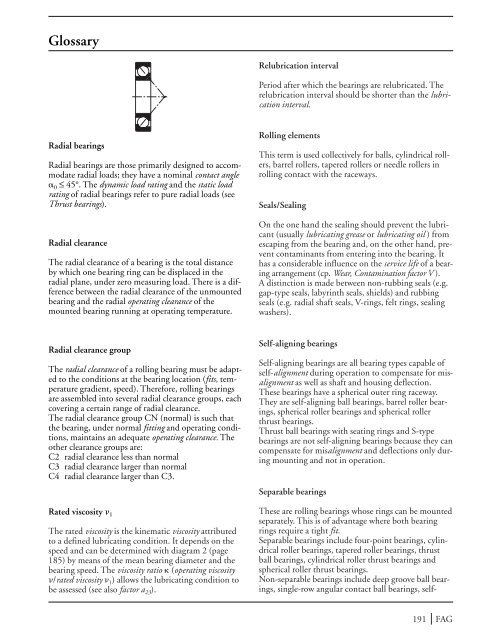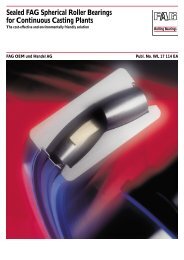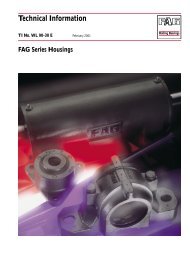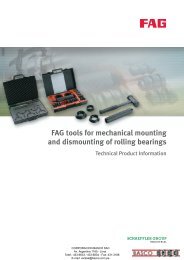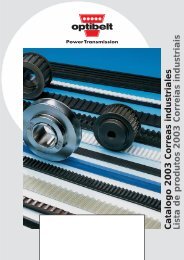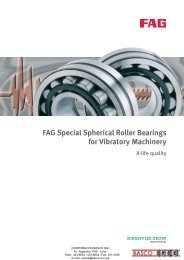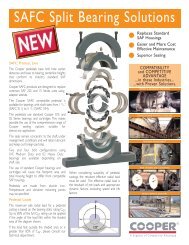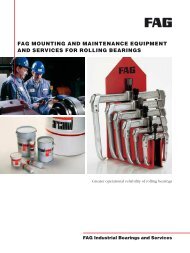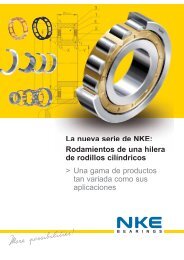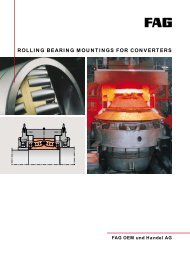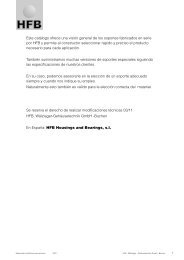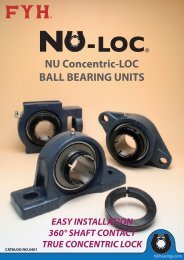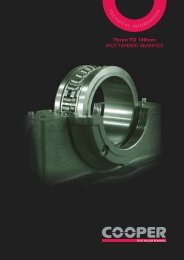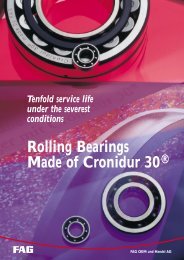You also want an ePaper? Increase the reach of your titles
YUMPU automatically turns print PDFs into web optimized ePapers that Google loves.
GlossaryRelubrication intervalPeriod after which the bearings are relubricated. <strong>The</strong>relubrication interval should be shorter than the lubricationinterval.Radial bearingsRadial bearings are those primarily designed to accommodateradial loads; they have a nominal contact angle 0 ≤ 45°. <strong>The</strong> dynamic load rating and the static loadrating <strong>of</strong> radial bearings refer to pure radial loads (seeThrust bearings).Radial clearance<strong>The</strong> radial clearance <strong>of</strong> a bearing is the total distanceby which one bearing ring can be displaced in theradial plane, under zero measuring load. <strong>The</strong>re is a differencebetween the radial clearance <strong>of</strong> the unmountedbearing and the radial operating clearance <strong>of</strong> themounted bearing running at operating temperature.<strong>Rolling</strong> elementsThis term is used collectively for balls, cylindrical rollers,barrel rollers, tapered rollers or needle rollers inrolling contact with the raceways.Seals/SealingOn the one hand the sealing should prevent the lubricant(usually lubricating grease or lubricating oil ) fromescaping from the bearing and, on the other hand, preventcontaminants from entering into the bearing. Ithas a considerable influence on the service life <strong>of</strong> a bearingarrangement (cp. Wear, Contamination factor V ).A distinction is made between non-rubbing seals (e.g.gap-type seals, labyrinth seals, shields) and rubbingseals (e.g. radial shaft seals, V-rings, felt rings, sealingwashers).Radial clearance group<strong>The</strong> radial clearance <strong>of</strong> a rolling bearing must be adaptedto the conditions at the bearing location (fits, temperaturegradient, speed). <strong>The</strong>refore, rolling bearingsare assembled into several radial clearance groups, eachcovering a certain range <strong>of</strong> radial clearance.<strong>The</strong> radial clearance group CN (normal) is such thatthe bearing, under normal fitting and operating conditions,maintains an adequate operating clearance. <strong>The</strong>other clearance groups are:C2 radial clearance less than normalC3 radial clearance larger than normalC4 radial clearance larger than C3.Rated viscosity 1<strong>The</strong> rated viscosity is the kinematic viscosity attributedto a defined lubricating condition. It depends on thespeed and can be determined with diagram 2 (page185) by means <strong>of</strong> the mean bearing diameter and thebearing speed. <strong>The</strong> viscosity ratio (operating viscosity/rated viscosity 1 ) allows the lubricating condition tobe assessed (see also factor a 23 ).Self-aligning bearingsSelf-aligning bearings are all bearing types capable <strong>of</strong>self-alignment during operation to compensate for misalignmentas well as shaft and housing deflection.<strong>The</strong>se bearings have a spherical outer ring raceway.<strong>The</strong>y are self-aligning ball bearings, barrel roller bearings,spherical roller bearings and spherical rollerthrust bearings.Thrust ball bearings with seating rings and S-typebearings are not self-aligning bearings because they cancompensate for misalignment and deflections only duringmounting and not in operation.Separable bearings<strong>The</strong>se are rolling bearings whose rings can be mountedseparately. This is <strong>of</strong> advantage where both bearingrings require a tight fit.Separable bearings include four-point bearings, cylindricalroller bearings, tapered roller bearings, thrustball bearings, cylindrical roller thrust bearings andspherical roller thrust bearings.Non-separable bearings include deep groove ball bearings,single-row angular contact ball bearings, self-191 FAG


